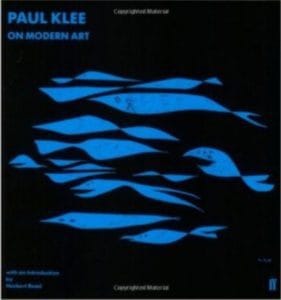 FROM THE VAULT | Paul Klee on Modern Art
FROM THE VAULT | Paul Klee on Modern Art
by Dr. Mark David Major, AICP, CNU-A, The Outlaw Urbanist contributor
Paul Klee on Modern Art (with Introduction by Herbert Read) is the text of a lecture delivered in 1924 at the opening of a museum exhibit of modern art (thus it reads in the first person). It is a series of brief commentaries on the Modernist creative process. Herbert Read’s brief but excellent introduction is an enlightening, concise summary of Klee’s intent in the lecture as well as the difficulties some readers might encounter while reading the text. Because Klee focuses on the creative process, he looks inward rather than outward (as he did in Creative Confessions), which gives the text a bit of an ego-centric viewpoint. In this sense, Modern Art is really about the artist in the world (in this case, Klee himself). Klee’s explicit reservations about speaking about his art also tends to make Modern Art feel somewhat defensive.
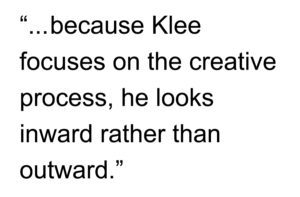 Because of this, Modern Art is not as rich with interesting observations, concepts and quotes that might find a common expression in architecture or urban planning (except perhaps its worst excesses, i.e. the architectural genius). Indeed, some of Klee’s text seems to pull back on his thoughts in Creative Confessions. For example, he states “line is the most limited”, which seems to contradict the ‘inherent energy’ he discussed in the other work. Instead, he shifts his focus to tone and color as an unmeasurable ‘quality’ in art, with explicit references to ‘mood’ in the artist and the emotions provoke in the character of a piece of art. In this sense, Modern Art represents a counter (and lesser) movement to Creative Confessions, of more limited application outside the realm of the artistic compulsion itself where there is “more value on the powers (i.e. the artist) which do the forming than the final forms themselves” residing “in the womb of nature” where the artist literally becomes a God himself in a creative act of genesis.
Because of this, Modern Art is not as rich with interesting observations, concepts and quotes that might find a common expression in architecture or urban planning (except perhaps its worst excesses, i.e. the architectural genius). Indeed, some of Klee’s text seems to pull back on his thoughts in Creative Confessions. For example, he states “line is the most limited”, which seems to contradict the ‘inherent energy’ he discussed in the other work. Instead, he shifts his focus to tone and color as an unmeasurable ‘quality’ in art, with explicit references to ‘mood’ in the artist and the emotions provoke in the character of a piece of art. In this sense, Modern Art represents a counter (and lesser) movement to Creative Confessions, of more limited application outside the realm of the artistic compulsion itself where there is “more value on the powers (i.e. the artist) which do the forming than the final forms themselves” residing “in the womb of nature” where the artist literally becomes a God himself in a creative act of genesis.
 Paul Klee on Modern Art
Paul Klee on Modern Art
by Paul Klee (with Introduction by Herbert Read)
55 pages
Faber and Faber Ltd. London. Paper Covered Editions (1967)
You can purchase Paul Klee on Modern Art from Amazon here.
Check out the Artsy.net Paul Klee page here.
From the Vault is a series from the Outlaw Urbanist in which we review art, architectural and urban design texts, with an emphasis on the obscure and forgotten, found in second-hand bookstores.

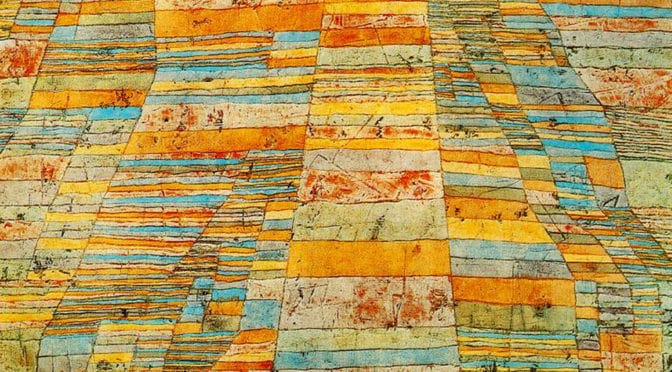
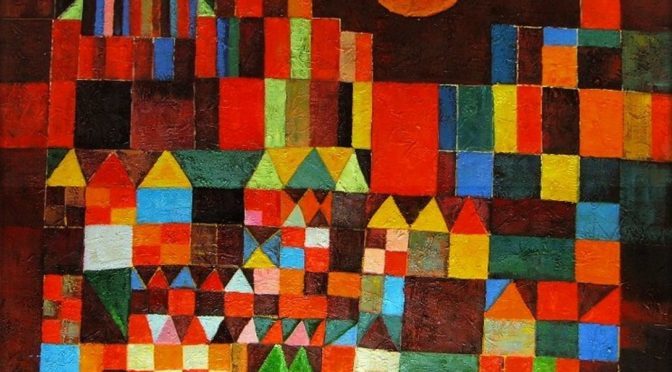
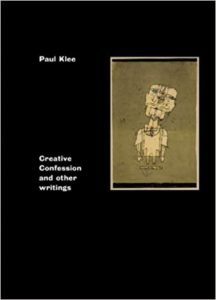
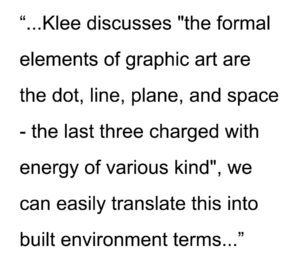 (dot=location, line=axis of movement, plane=convex space, and space itself is self-explanatory). Klee means this in terms of the energy of artistic gesture but we can also easily understand how these things in an urban environment are similarly ‘charged with energy’ in terms of movement, avoidance, and encounter.
(dot=location, line=axis of movement, plane=convex space, and space itself is self-explanatory). Klee means this in terms of the energy of artistic gesture but we can also easily understand how these things in an urban environment are similarly ‘charged with energy’ in terms of movement, avoidance, and encounter.
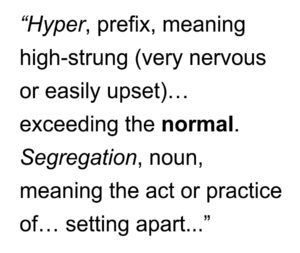 observation of individuals or items from another group: the institutional separation of an ethnic, racial, religious, or other minority group from the dominant majority; the state or condition of being segregated, set apart, separated, or restricted to one group. Origin of hyper is short for hyperactive (First Known Use: circa 1942) from Greek huper ‘over, beyond.’ Origin of segregation is 1545-55 from the Late Latin sēgregātiōn– (stem of sēgregātiō), equivalent to sēgregāt (us) (see segregate) + –iōn– –ion. Synonyms include extreme loneliness and excessive isolation to the point of being unhealthy for individuals or society.
observation of individuals or items from another group: the institutional separation of an ethnic, racial, religious, or other minority group from the dominant majority; the state or condition of being segregated, set apart, separated, or restricted to one group. Origin of hyper is short for hyperactive (First Known Use: circa 1942) from Greek huper ‘over, beyond.’ Origin of segregation is 1545-55 from the Late Latin sēgregātiōn– (stem of sēgregātiō), equivalent to sēgregāt (us) (see segregate) + –iōn– –ion. Synonyms include extreme loneliness and excessive isolation to the point of being unhealthy for individuals or society.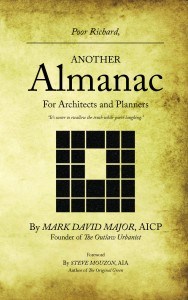
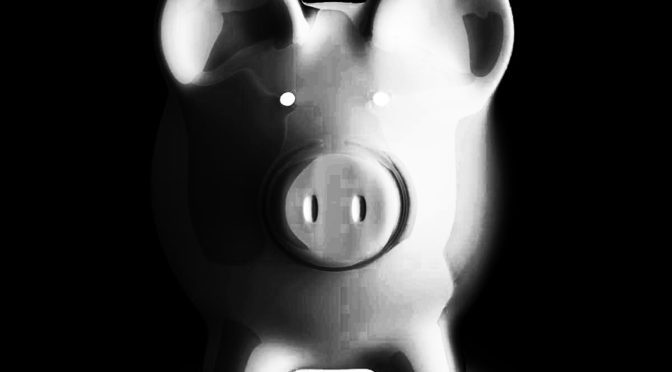
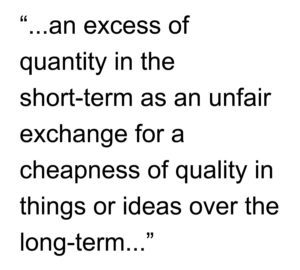 In cities, this most often refers to an excess of quantity in the short-term as an unfair exchange for a cheapness of quality in things or ideas over the long-term. For example, a cheap idea efficiently implemented in the short term is often inevitably more expensive than a good idea carefully crafted and implemented over the long term. Synonyms include: miserliness, niggardliness, penny-pinching, or tightfistedness; see also FUBAR (Fucked Up Beyond All Recognition) or clusterfuck. (1400-50; late Middle English parcimony < Latin parsimōnia, parcimōnia frugality, thrift, equivalent to parsi– combining form of parsus, past participle of parcere to economize or parci– combining form of parcus sparing + –mōnia –mony suffix signifying action, state, or condition).
In cities, this most often refers to an excess of quantity in the short-term as an unfair exchange for a cheapness of quality in things or ideas over the long-term. For example, a cheap idea efficiently implemented in the short term is often inevitably more expensive than a good idea carefully crafted and implemented over the long term. Synonyms include: miserliness, niggardliness, penny-pinching, or tightfistedness; see also FUBAR (Fucked Up Beyond All Recognition) or clusterfuck. (1400-50; late Middle English parcimony < Latin parsimōnia, parcimōnia frugality, thrift, equivalent to parsi– combining form of parsus, past participle of parcere to economize or parci– combining form of parcus sparing + –mōnia –mony suffix signifying action, state, or condition).
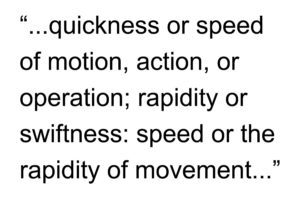 It is measured in metres per second, miles per hour, etc: the derivative of position with respect to time; a rate of occurrence or action, the rate of speed with which something happens; rapidity of action or reaction; the rate of turnover (Middle French velocité, from Latin velocitat-, velocitas, from veloc-, velox quick or swift; probably akin to Latin vegēre to enliven – more at wake; related to volāre to fly. See velocipede, -ty: First Known Use: 15th century).
It is measured in metres per second, miles per hour, etc: the derivative of position with respect to time; a rate of occurrence or action, the rate of speed with which something happens; rapidity of action or reaction; the rate of turnover (Middle French velocité, from Latin velocitat-, velocitas, from veloc-, velox quick or swift; probably akin to Latin vegēre to enliven – more at wake; related to volāre to fly. See velocipede, -ty: First Known Use: 15th century).